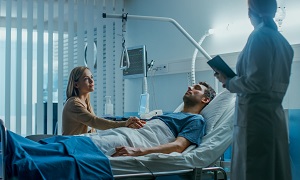Best Brachytherapy Doctors & Hospitals in India
Best Brachytherapy Hospitals India
- City: New Delhi, India
Hospital Highlights:
- Established in 1996, Pushpawati Singhania Research Institute is one of the top hospitals in the NCR region, as well as one of the top facilities in India for gastroenterology. The hospital is one of South Asia’s first institutes in medical and surgical treatment for diseases related to digestion.
- The hospital is equipped with state-of-the art facilities coupled with the latest equipment as well as renowned consultants from various parts of India as well as other parts of the world.
- City: Chennai, India
Hospital Highlights:
- RIMC is a multi-specialty hospital in a sprawling area of 36 acres located in Chromepet, Chennai, Tamil Nadu, India.
- The facility has 450 beds including 130 critical care beds, 9 operating rooms, modern reference laboratories and radiology services, and is conveniently located near road, rail and air transportation.
- RIMC is led and managed by world-renowned physicians committed to healthcare.
- RIMC offers the broadest range of clinical care, education, and research. The hospital offers state-of-the-art technology and modern treatment facilities designed to provide health care at an affordable cost.
- Rela Institute is driven by patient needs, comfort and confidence.
- City: New Delhi, India
Hospital Highlights:
- Sir Ganga Ram Hospital, New Delhi is known to provide the latest medical procedures with the latest technology in all of its units.
- The hospital has a team of reputed doctors, nurses, and healthcare professionals that ensure that patients receive quality care at affordable costs.
- Staffed with a team of highly qualified doctors, dedicated nurses, and paramedical and non-medical staff, the hospital aims to lead in healthcare delivery, medical education, training, and research.
- As per the vision of the founder, the hospital also provides free treatment to the economically weaker sections of society.
- Sir Ganga Ram Hospital also provides training to young doctors under the Diplomate in National Board(DNB) program. The DNB program at the hospital was started in 1984 and it is known for currently running the maximum number of DNB specialties in the country. It also has the distinction of having the first bone bank in India.
- City: Mumbai, India
Hospital Highlights:
- Reliance Hospital is one of the best super-specialty care hospitals in Navi Mumbai.
- The main purpose of this hospital is to become a trustworthy place for the best health and hope for society. The hospital is well connected to the suburbs of Mumbai and Navi Mumbai.
- The hospital has various specialty departments, viz., Accident & Emergency, Anesthesiology, Dental Services, Dermatology, Diabetology, Dietetics Nutrition, Endocrinology, ENT, Gastroenterology, General Surgery, Gynaecology And Obstetrics, Hepato Pancreato Biliary Surgery, Infectious Disease, Internal Medicine, Interventional Radiology, Laboratory Medicine, Minimal Access Laparoscopic Surgery, Nephrology, Neurosciences, Opthalmology, Orthopaedics, Paediatrics, Pain Management Palliative Care, Physical Medicine Rehabilitation, Plastic And Reconstructive Surgery, Psychiatry, Pulmonary Medicine, Radiology, Rheumatology, Transplant, Urology Andrology, Vascular Surgery
- City: Mumbai, India
Hospital Highlights:
- SL Raheja hospital is a 140-bed multi-specialty tertiary care hospital that is being managed by Fortis Healthcare Ltd.
- The hospital is a benchmark in healthcare and medical facilities in the neighborhood of Mahim & the western suburbs.
- L.Raheja Hospital, Mahim has one of the most effective ICU and Casualty care services.
- The hospital provides specialty medical services in Cardiology, Oncology, Neurology, Orthopedics, Mother & Child Care, and in Diabetes.
- City: New Delhi, India
Hospital Highlights:
- State-of-the-art technology and devoted healthcare professionals have been brought together under one roof at Venkateshwar Hospital to provide genuine medical care. The hospital’s professionals work together as a team to deliver the best possible treatment to their patients, using the most sophisticated equipment and information technology.
- Venkateshwar Hospital’s mission is to attain global excellence in healthcare by employing evidence-based, ethical clinical practices and cutting-edge technology by a team of highly skilled experts.
- City: Gurugram, India
Hospital Highlights:
- W Pratiksha Hospital, Gurugram, is one of the best hospitals in the NCR region. It is also a top hospital in India for IVF. Since its inception, the hospital has performed over 5500 successful IVFs. The hospital also specializes in gynecology.
- With over 20 years of experience in providing quality healthcare, the hospital is known as one of the most trusted and valued health providers in India.
- Equipped with world-class medical facilities and advanced technology, the hospital’s doctors and clinicians also have a track record of delivering excellent results. The hospital is also known for focusing on preventive well-being as much as on curative treatment.
- The hospital has earned the trust of its patients, by providing the best available treatments at affordable costs.
- City: Mumbai, India
Hospital Highlights:
- Wockhardt Hospitals were established in the year 1973, originally called First Hospitals and Heart Institute.
- Wockhardt Hospitals are super specialty health care networks in India, nurtured by Wockhardt Ltd, India’s 5th largest Pharmaceutical and Healthcare company.
- Wockhardt Hospitals is associated with Partners Harvard Medical International, an international arm of Harvard Medical School, USA.
- Wockhardt Heart Hospital performed India’s first endoscopic heart surgery.
- The hospital has a state-of-the-art infrastructure equipped with the latest technologies and modern equipment.
- It has special Centers of Excellence dedicated to the major specialties to provide hassle-free and high-quality clinical care.
Brachytherapy
Gone are the days when Cancer Treatment only meant chemo or external radiation therapy. Thanks to the medical science advancement, cancer treatment methods have undergone some recent changes with new, more focused treatment methods cropping up on the scene! Brachytherapy is one such treatment method that focuses on cancer tumors by placing small radioactive implants as close to the tumor location as possible.
One of the primary reasons why Brachytherapy is recommended, because this therapy focuses on high doses over a small space with the radiation concentrating on the tumor and not on the surrounding tissues or cells. This prevents damage or harm to the surrounding areas of the tumor.
Now you must be wondering how Brachytherapy works with such precision and we’ll get to that, but before we do, let’s breakdown the basics of this treatment style starting with the question-
What is Brachytherapy?
In its simple form, Brachytherapy can be defined as a type of internal radiation in which an implant, which can be anything from wires or seeds to capsules, with a radiation source in it is directly placed inside the body, closer to the tumor. Also known as Internal Radiation Therapy, this form of therapy can effectively shrink the tumor size if not downright eliminate it from your system and can be used to treat cancer types such as-
- Lungs
- Breast
- Prostate
- Head & neck
- Eye
- Uterus, etc.
What are the Different Brachytherapy types?
Primarily, there are two types of Brachytherapy:
Low Dose Rate (LDR) Brachytherapy
- Low Dose Brachytherapy also known as permanent brachytherapy, is a continuous treatment process where a radioactive implant is permanently inserted (either manually or through a machine) in your body and a low dose of radiation seeps out of it continuously for weeks, maybe months, depending on the intensity or growth rate of the tumor. The radioactive implant will release a particular dose of radiation and would focus on gradually shrinking or weakening the tumor.
- In this procedure, you may be asked to detain yourself in the hospital due to the presence of radiation within your body. Even though it’s not harmful, you’ll be kept in a private room with limited visitor access (no children or pregnant women).
- The insertion of the brachytherapy device will not be painful since in most cases anesthesia is used to reduce discomfort. In fact, the presence of the radioactive implant in your body shouldn’t cause any pain or discomfort and if it does, notify your medical team immediately.
High Dose Rate (HDR) Brachytherapy
- High Dose Brachytherapy also known as temporary brachytherapy, is more of a session-wise treatment procedure where radioactive implants are temporarily placed within the body and the therapy continues for a few minutes, up to half an hour itself. Post this, the temporary radiation tube is removed and you can return back to your normal lifestyle without any hassle.
- Since HDR Brachytherapy session is brief, these are recommended for outpatients only which means you don’t have to stay back in the hospital or in isolation. Your medical team may recommend up to 2 sessions of a few minutes each in a day and once the tube is removed, you are free to go. You will also not be radioactive which means you can meet people after your session.
- During the HDR procedure, the radioactive material will be inserted using a computerized machine. Your medical team will leave you alone in the room to avoid unwanted exposure but they will closely monitor you from a nearby room. You can notify them if you feel discomfort or pain, but in most cases, the patients don’t. Once the procedure is done, your medical team will come back in, remove the radiation device and you’ll be free to move about.
Who will your medical team consist of?
Much like any other cancer cure team, there will be some core professionals consisting of radiation oncologists, radiation therapists, dosimetrist to measure your dose, a general physicist on standby (for health ailments occurring during the procedure). There will also be a support team of anesthesiologists, surgeons (to insert or extract implants) and nurses for general care during and after the procedure.
How do you prepare for your brachytherapy?
Once diagnosed and determined, your medical team will decide if Brachytherapy is a suitable option for your condition. Once determined, you will be asked to share a detailed report of your medical history including ongoing medications, health supplements, etc. Consult with your healthcare team for dietary regulations and if any is necessary or not! Your doctor may prescribe certain clinical tests to understand your condition better which can be in the form of :
- EKG
- MRI/ CT scan / Ultrasound
- Certain blood tests
- Chest X-Ray or other imaging tests
- Bowel preparation
What to expect during the Brachytherapy procedure?
Now let us give you a step by step breakdown of what you might expect during this procedure!
Pre-procedure
You’ll have a brief meeting with your medical team before the Brachytherapy procedure during which your doctor/nurse will go over some preliminary exams which may include imaging tests, physical exams, discussing the procedure including side-effects and so on. During this period, patients are requested to share an in-depth report of their medical histories which should also include ongoing medication, intake of health supplements or blood thinners such as aspirin and more. You can even discuss post-procedure care along with dietary regulations or preventative measures.
During the procedure
So by now, you’re aware that Brachytherapy requires focused radiation to eliminate cancer cells, but are you aware of where the implants are placed? Even though the aim is to place the implants as close to the tumor as possible, there are a lot of variables that need to be taken into account. For instance, there are 3 primary locations that are frequently used and they can be:
- Intracavitary Treatment- In this method, the implant is inserted inside cavities within the body, such as uterus or breasts
- Interstitial Treatment- In this method, the implant is inserted right inside the tumor mass.
- Internal Radiation Therapy- In this method, the radiation is inserted in the form of a medicine, preferably through a vein or into a body cavity.
Depending on the procedure type you may have to stay back in the hospital for a few nights or be in an isolated room while your temporary radiation procedure takes place. You can refer to our Different Brachytherapy Types segment to know more about this.
Post-procedure radiation management & brachytherapy
There is always a chance that the radiation source in your body may make you radioactive for a brief span of time which is why patients are often requested to stay indoors, preferably isolated for a while. This is more common in high-dose brachytherapy where the radiation source is implanted inside the body.
This also means visitors with chronic illnesses, children and pregnant women should avoid coming in contact with you. In fact, visitor meet and greet should be kept zero or at the minimum to avoid unnecessary exposure.
FAQs
1. What are some of the Brachytherapy side effects I should be aware of?
Both LDR and HDR may come with certain side-effects. The most immediate ones that occur right after the procedure can be urinary problems including blood in the urine or frequent need to pass urine. Some later symptoms may include constipation.
2. How long will the implant stay in my body?
This solely depends on your cancer cure rate. Depending on the severity of the condition or your body’s reaction to this procedure, the implants may stay for weeks and even months. However, once the radiation oozes out of the implants, they won’t stay active anymore.
3. How would doctors know if the procedure is working or not?
4. Will I feel pain and discomfort during this procedure?
Even though the implant plantation itself can be a little painful (which is why doctors use anesthesia for this part), once the implant is inside, you shouldn’t feel any pain or discomfort.











